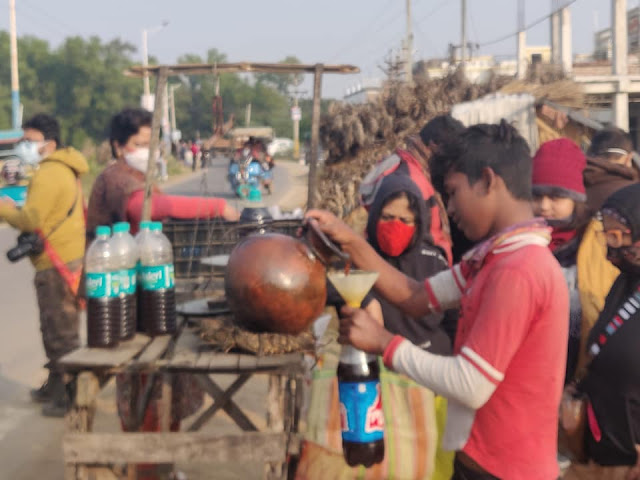I do not have much of a sweet tooth, and being a Bengali this has often led to a bit of ridicule from friends and family. A few of my favourites though are Jilipi (the jalebi from Bengal), Mishti Doi and Lyangcha. But on top of my charts is always the winter delicacy that you yearn for, the sweets and desserts prepared from palm date jaggery or Nolen Gur as it is known as.
The word “Nolen” means new, as the flavour of the jaggery is at its peak when it is prepared fresh during the winter months. Many districts of rural West Bengal claim to produce the best Khejur Gur (the sugarcane version called Bheli or Akhi gur is mainly from Uttar Pradesh and Maharashtra). In fact some individual villages are known for the quality of their gur.
 |
| Patali Gur |
In December last year, I was at Santiniketan, and my little knowledge of how gur is prepared got augmented at a field off Phuldanga. Date trees lined up on one side of the field, while on the road, enthusiasts were enjoying the first output from the earthen pitchers carefully downloaded from the trees during dawn – the date juice or Khejurer Ras which is so so refreshing. It is another matter that as the day progresses this same juice left in the pitcher ferments and by noon becomes a potent alcohol to put you on a high. Just next to the person selling the ras (or juice) was a squarish earthen stove fueled by wood, where the ras was being boiled in a metal tray and gradually condensed into nolen gur.
The preparation of gur is an elaborate process. The people who are in the profession of preparing the gur go by the name of “Shiuli” in Bengal. The work of a shiuli is very tough. In the wintry evenings they climb the date tree, and place an earthen pitcher just below the branches. A gash is made on the tree to enable the sap to flow and collect in the pitcher. Then again in the wee hours of the morning, it is a climb up the dew moist slippery tree to collect the pitcher and carefully bring it down. The process of making the date jaggery starts from there. The sap condenses into liquid nolen gur on a wooden fire, and some part of that is further made into hard Patali (or hard chunks).
Many Bengali households buy large quantities in winter to last a few months where they can use these for their many desserts like payesh, patisapta, and sandesh. However, the gur progressively loses its flavour over time and very few varieties retain much of it even after a year. There is another version of date jaggery known as “Jiren Gur” where the sap is collected from the tree after a gap (or rest) for a few days.
The gur made in the villages is sold in the local markets, and some of the better ones make their way to the wholesalers in district towns and cities. In North Kolkata there are large wholesalers (known in Bengal as “gurer arat”) where you can find the finest nolen and patali from different districts of Bengal. Some of them also supply these to large customers like sweet shops all over India and even parts of the world.
 |
| Srimanta Gurer Arat, a 200 year old wholesale outlet in Sovabazar |
Couple of years back, my blogger friend Indrajit Lahiri had taken me to a 200-year old shop in Shovabazar Gur Patti known as Srimantar Gurer Arat where I was privy to getting educated about different varieties of gur and their favours. The shop gets different varieties of gur from all over Bengal and supplies to clients in India and abroad (including Hyderabad’s own Delhi Mithaiwala and Dadus). They had invited Indrajit for a briefing on an overview of their trade and I had tagged along. Subrata Mitra, a young food lover who organized this visit, was also with us.
The knowledge that we could acquire about the various types of Nolen gur from many districts of Bengal was simply phenomenal (though it must only be tip of an iceberg). The best nolen gur as per the current owner Mr Tanmay Bera (great grandson of Late Srinath Chandra Bera who founded the shop) is not from Joynagar in South 24-Parganas as we all know, but from Majhdia near Krishnanagar and from Gede close to Bangladesh border. We were also told that more dark the colour in the gur, better is the quality, and the best patali gur these days are from Jalangi in Murshidabad.
The smaller cup shaped patali gur is called Muchi Patali whereas the thali shaped ones are called Thala Patali. There is also tinned patali gur. It seems the best sweet shops use nolen gur to make their sweets, whereas the more economical ones use a mix of nolen and patali. I have never seen so much gur in my life, stacked up by their origin location, density and quality. As per them, there is often adulteration with sugar which makes the patali harder. Good patali will be of a soft texture.
Newer interesting packaging of nolen gur are making it more user-friendly. Biswa Bangla, the West Bengal government initiative and some private suppliers now supply small quantities in user-friendly tubes, where you can just push out the gur with an ease.
 |
| With the owners of Srimanta Gurer Arat |
The use of nolen gur is not just restricted to traditional Bengali sweets. There are many innovative and experimental recipes where the gur is used in preparing a whole range of food, including even cocktails and ice creams. More about it in another post in the near future.









